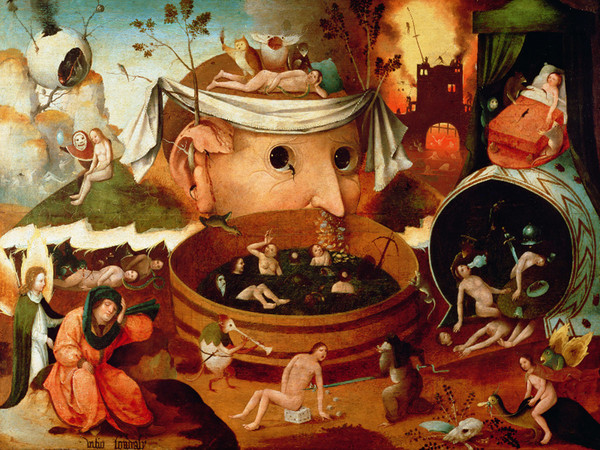In his paintings, he deforms nature with his ruthless imagination: Who is Hieronymus Bosch van Aken?
In his paintings, he creates repulsive and terrible forms to disfigure, detest, and mock the enemies of Jesus.

(1450-1516) Flemish painter. He is the most interesting of the Northern painters of the Late Middle Ages with his unique artistic personality stemming from his extraordinary power of creation and interpretation. There is not much information on his life, and the known dates are uncertain. It is believed that he was born there, as his name is mentioned in the records of the town of Hertogenbosch (Bois-le-Duc) in the Brabant region of the Netherlands. There are many painters in his family. He became famous with his works while he was still alive, and was called "insignis picture" (a distinguished painter) after his death.
Hieronymus Bosch (1450 – 9 August 1516) was a Dutch/Netherlandish painter from Brabant. He is one of the most notable representatives of the Early Netherlandish painting school. His work, generally oil on oak wood, mainly contains fantastic illustrations of religious concepts and narratives. Within his lifetime his work was collected in the Netherlands, Austria, and Spain, and widely copied, especially his macabre and nightmarish depictions of hell.
As a creator of form, Bosch stands alone as a unique painter in the 15th century. He is considered a satirist and a pioneer of Surrealism. It has also been suggested that he has ties to secret sects. His paintings attracted attention in his era and were copied. This interest continued until the end of the 16th century. For example, the Flemish artist Pieter Cock has published engravings of Bosch's compositions. It is believed that he showed them to his son-in-law, Pieter Bruegel, in the 1550s.
The relationship between people and the surface of the painting determines the perspective in Bosch's paintings, the human figure does not interest him much; he doesn't care about the weight, volume, and personal details of the body. The human figure that he defines with simple contours is only a tool for him. The people he puts in front of the landscape as ordinary objects are not really placed in a painting space. It is as if they are not enveloped in air, but Bosch nevertheless aimed for the landscape-figure union. In his landscapes, the skyline is high, as if viewed from the top of a tower; the people in the same picture are drawn according to another lower horizon line. This two-sidedness and archaic inconsistency in the perspective does not allow a correct impression of depth in the eye of the beholder. The depths of the various planes of the landscape are meticulously sculpted by line and color, but still
As a human observer, Bosch foreshadows Bruegel. With his ruthless imagination, he deforms nature and changes its meaning. The Christian concept of "passion," that is, suffering and suffering for the sake of religion, takes the form, in Bosch, of the diabolical and excessive imagination of evil. In his paintings, he creates repulsive and terrible forms to disfigure, detest, and mock the enemies of Jesus.
He creates fictional monsters with elements taken from real beings in carefully selected topics. He opposes the laws of nature with his imagination, mocking the difference between man and animal, between man's work and nature. His mastery of giving a certain reality to the strange creatures he adds to the images of superstition and fear of hell is unmatched. He is not a portraitist; He is not interested in the person, he likes the anomalies, excesses, and caricatured aspects of the person. They are weak, pale-faced sick people. It brings together imaginary creatures, creatures from nightmares, figures of fruit, birds, and young women; because the expressionist view includes the pleasing, the pure, and the ideal.
Bosch also used symbols related to astrology, witchcraft, and alchemy. In his paintings, every detail in the whole carries a symbolic meaning. The whole itself is a kind of allegory. This set of forms always reflects certain themes with their startling interpretations: sin, straying from the path of Jesus, over-attachment to earthly pleasures, vain pride, the power of faith, the virtue of suffering, and so on. No matter how far ahead of its time Bosch is with its intellectual independence and creative courage, it belongs to the 15th century in form and technique. Its pattern is archaic, with sharp lines; The painting technique, on the other hand, consists of overlapping thin transparent layers. He creates almost transparent forms from a profile like a statuette making medallions and reliefs. The bodies he draws are flattened on the surface, in silhouettes with a decorative appeal.
It uses the own color of the objects; It works with very subtle, elegant, light tones, mostly combining pink, purple, pale green, yellow, purplish-black, and blues. He appears as a master of gray color in his later works. These grays of his are broken with strong color accents in places and it gives the painting a sense of place and a poeticness.
Until recently, Bosch's art was not given due attention. Only seven of his 40 paintings that have survived are signed, and none of them has a date. For this reason, a precise order of his paintings cannot be made, but they can be roughly divided into periods according to the similarities between them. Most of Bosch's paintings are in the Prado Museum today, as they were collected by King Philip II of Spain.
